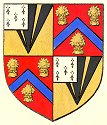 |
A SHORT HISTORY OF TETTENHALL13. The twentieth century |
|
 |
A SHORT HISTORY OF TETTENHALL13. The twentieth century |
|
|
At the beginning of the 20th century Tettenhall was still continuing the
even tenor of its way. The most notable event was the erection, in 1911,
of the clock tower on Upper Green. It was the gift of the local
landowners, Mr. and Mrs. E Swindley. This clock was to mark the
coronation of George V but its being on Upper Green, not Lower Green,
also marks the fact that the village’s centre of gravity had now clearly
moved from around Lower Green to around Upper Green.
The first world was affected the village as it affected every other village in the country and Tettenhall's share of the nation's appalling casualty list is recorded on the war memorial at the parish church.
Before the war a start had been made on the Oxley to Kingswinford
railway line, part of a scheme to link Stourbridge and Worcester to
Bridgnorth. Work was abandoned during the war (and the spur to
Bridgnorth never was built) and restarted after it, the line following
that of the Smestow and the canal. The line opened in 1925 with a
station at Tettenhall and a halt at Compton. But the passenger service
was not a success and lasted only until 1932. Goods traffic struggled a
long, the route being mainly used as a bypass. It finally closed in
1965, as part of the Beeching reorganisation of the railways. Most of
the line is now part of a linear park. Tettenhall's function as a residential area was emphasized by the building of new estates and the consequent disappearance of many farms. The first council houses in the Regis Road area were begun in 1922 and were followed by more in Woodland Avenue in 1927.
But some open land remained. In the early 1930s Mrs. E. Swindley left a great
deal of land to the village, from Upper Green across to Stockwell Farm,
whose duck pond was converted into a paddling pool at the expense of the
Graham family, the owners of the Express and Star. Mrs. Swindley also
left the cricket ground to the cricket club.
The Second World War also had a similar impact on Tettenhall as it had
on other
After World War II residential development continued with estates at
Long Lake, the Grange and the Woodhouse.
New schools were duly provided: primary schools at Castlecroft in
1952, at Westacre in 1954, Bhylls Acre in 1957 and Woodthorne in 1959.
Two comprehensives were also built: Regis is 1955 and Smestow a few
years later.
In 1950 St Michael and All Angels burnt down. The cause of that fire has
never been determined. The late 14th century tower and the interesting
later 19th century porch were saved and incorporated into the new
church, which was built in a very successful modern interpretation of
the gothic.
In the nearly forty years which have passed since then no major event has disturbed the subrural calm of Tettenhall. There has continued to be an extension of housing, especially at Perton, and Tettenhall has maintained its place as “Wolverhampton’s best bedroom”. |